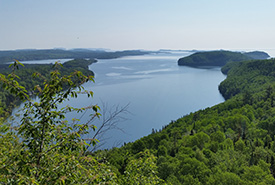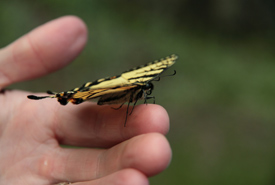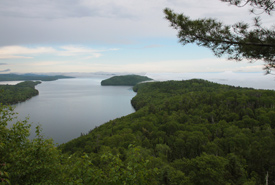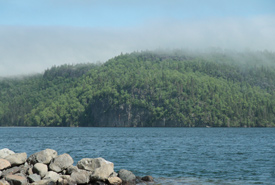My breathtaking adventure at Big Trout Bay

Looking down over Big Trout Bay, Lake Superior, ON (Photo by NCC)
As part of the communications team for the Nature Conservancy of Canada’s (NCC’s) Ontario Region, I get to see a lot of great photos of our properties. One, a beautiful photo of Big Trout Bay taken by John Anderson, had me dreaming of seeing the lush forest and vast waters depicted in the photo in real life.
My chance to visit Big Trout Bay came this past June, when NCC hosted three events and a board meeting over two days in Thunder Bay and Neebing, Ontario. Some of my co-workers and I were heading there to coordinate and participate in the celebration of the acquisition of the 2,500-acre (1,018-hectare) property.

Easten tiger swallowtail (Photo by NCC)
As we touched down at the Thunder Bay airport, the sky was beginning to darken. By the time we pulled into the hotel parking lot, we could hear the ominous rolls of thunder rumble across the bay. We checked into the hotel, dropped off our bags and changed into our most waterproof hiking gear. We crossed our fingers that the threatening storm would blow over so that we could go ahead with our hike.
When we met back at the car, we were greeted by the most beautifully clear skies. With renewed excitement thanks to the likelihood of a drier hike, we then set off for the Little Trout Bay Conservation Area in Neebing.
After a short, misty drive, we arrived at the conservation area. The storm we were so worried about earlier had fallen over Neebing and Trout Bay moments before our arrival, but left behind a wispy fog rolling out of the bay. It was beautiful. The sun was peeking through the remaining clouds and sparkling off the calm waters.
Being an amateur photographer and biodiversity enthusiast, I was overjoyed at the diversity and abundance of species. All of this life had me stopping every few steps to take pictures of everything from the smallest lichen to the largest tree, and calling out to the biologists in the group to help identify what I was photographing.

View of McKellar Point, ON (Photo by NCC)
At top of the ascent of our hike, the trees thinned out and I caught my breath. It was short-lived, as the view took my breath away again. The jagged rock of McKellar Point was covered in lush green trees and jutted out into the vast expanse of Lake Superior. The air was scented with damp moss and pine, and the vivid green of the new leaves on the trees contrasted with the steely blue waters of the lake below.
Suddenly, the buzz of a circling black fly brought me back and I remembered that I was supposed to be taking photos. I lifted my camera and framed the shot, sure that I couldn’t possibly do justice to what I was seeing, and snapped a photo. I was about to take another one when my screen went black. The camera’s battery was dead and I had left the spare in the car! My heartbreak was brief, however, as I took the camera away from my face and realized the view was still right there before me.

Little Trout Bay, ON (Photo by NCC)
The death of my camera’s battery was a blessing in disguise. No longer seeing the trail through my viewfinder, I was suddenly aware of the entire landscape; its vastness and the interconnectivity between species. This really is pristine wilderness, or at least as close to it as most of us will ever experience. The only evidence that any human had ever been through this part of the forest were our own footprints, something which I had never really experienced before.
Setting foot on lands protected by NCC put into context the photographs I had been seeing on my computer for months. I was able to feel and see first-hand the positive impact NCC’s work has on Canadian landscapes and biodiversity. After reviewing the photos I took during my time on Lake Superior, it became clear that no photo could ever do the landscape justice. The best way to appreciate landscapes is to get out and experience them for yourself.


